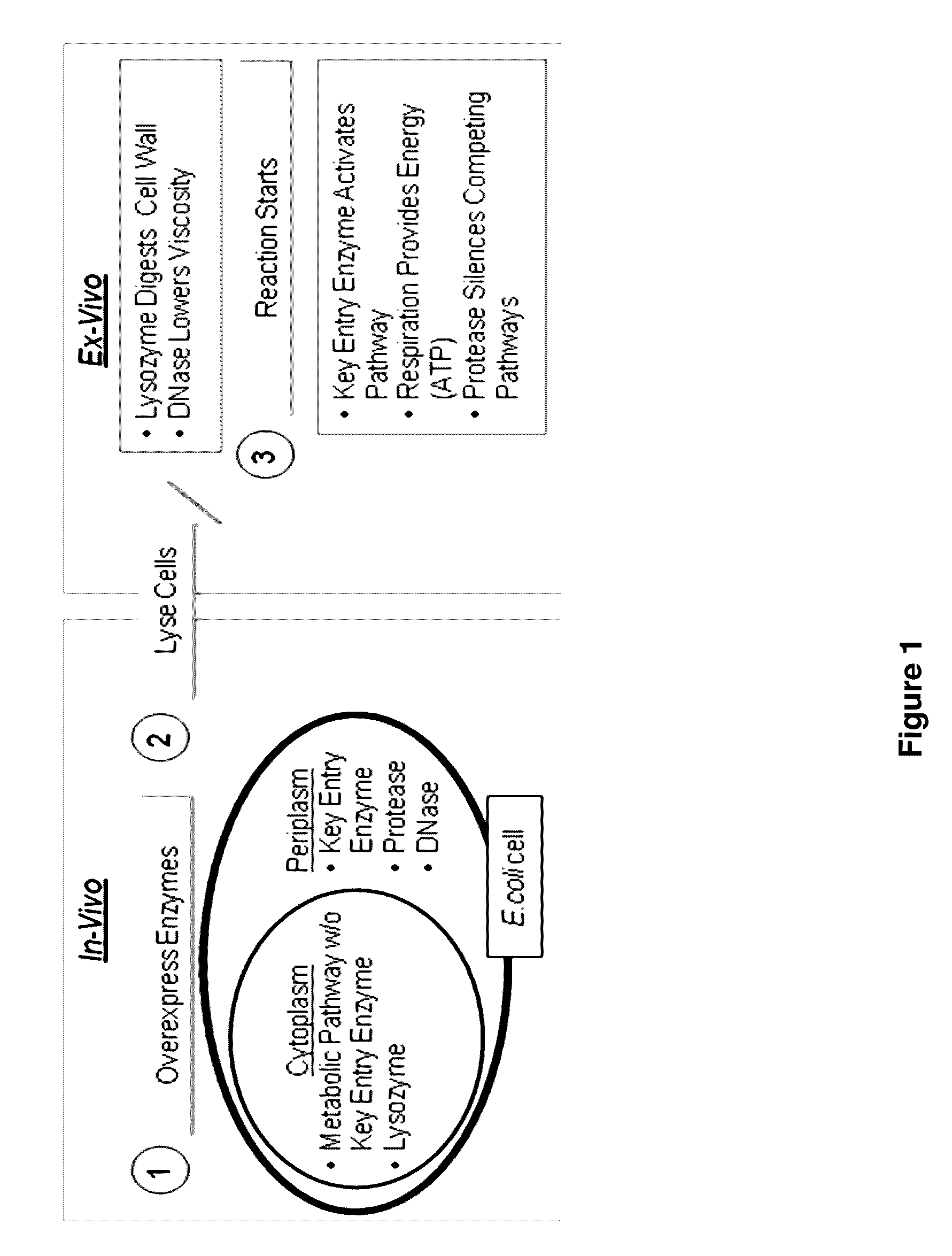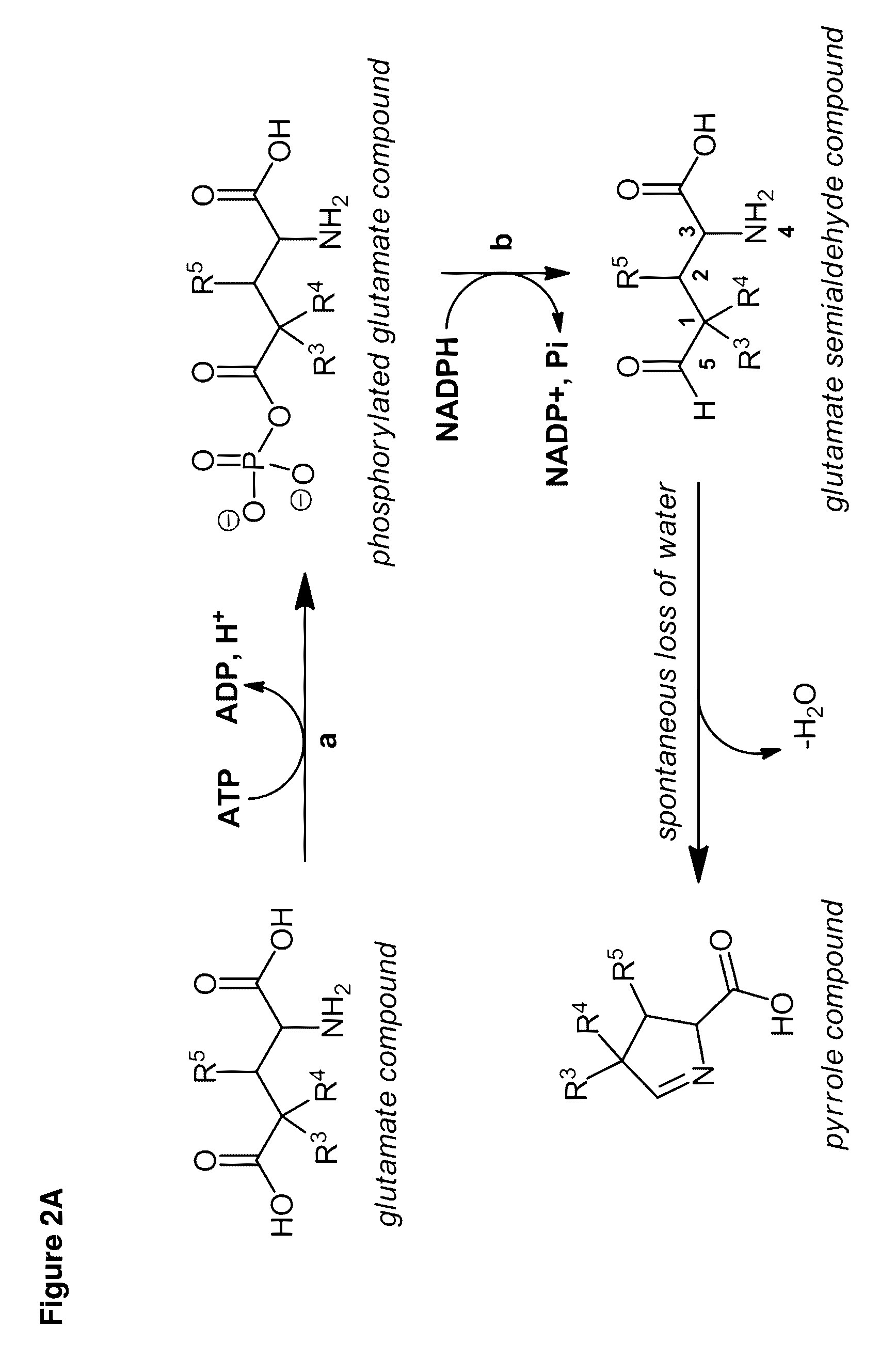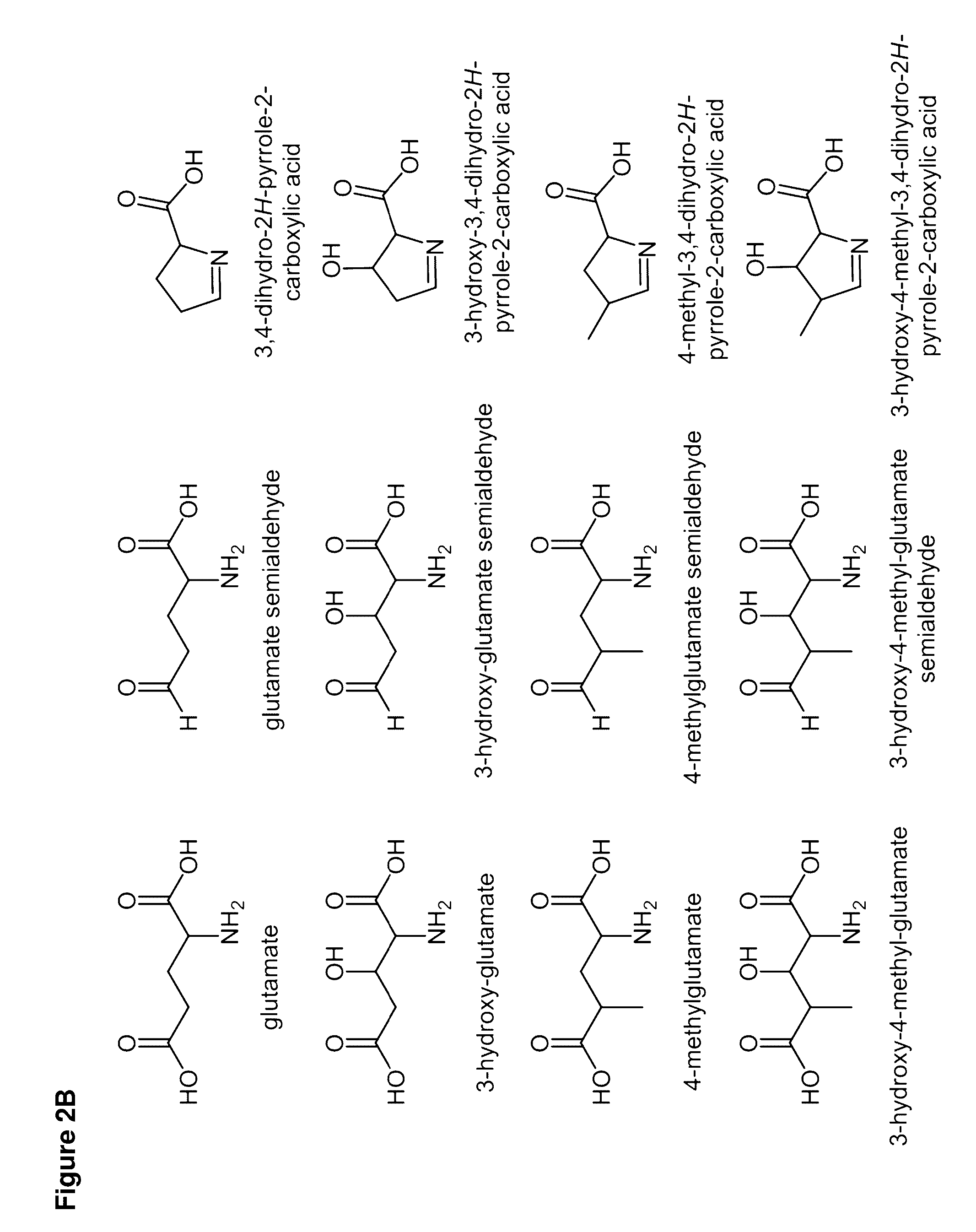Cell-free preparation of carbapenems
a technology of carbapenem and cell-free preparation, which is applied in the direction of transferases, bulk chemical production, applications, etc., can solve the problems of difficult isolating and purification, low titer, and difficulty in isolating and purifying, so as to enhance the pharmacokinetic and/or pharmacokinetic properties associated, improve the physical and/or delivery properties, and enhance the water solubility
- Summary
- Abstract
- Description
- Claims
- Application Information
AI Technical Summary
Benefits of technology
Problems solved by technology
Method used
Image
Examples
example 1
Production of Substituted Carboxy-Methylproline Molecules from Substituted Glutamate and Malonyl-CoA or Ethylmalonyl-CoA
[0432]BL21(DE3) strain containing plasmids expressing ProB, ProA, and CarB was grown to high cell density, lysed, and cell debris were removed via centrifugation. Clarified lysate (30% final reaction volume, 3.9 mg / ml protein) was incubated with 5 mM of one of the following: glutamate, 4-hydroxy-glutamate, or 4-methyl-glutamate together with 1.6 mM ethylmalonyl-CoA, 3 mM ATP, 3 mM NADPH, and 2 mM MgCl2 for 60 min at 37° C. Reactions without substrates were included as controls. Ethanol-quenched reactions were analyzed by LCMSMS using the method below:
[0433]
ColumnPhenomenex Synergi Polar RP, 250 × 4.6 mm, 4 mmMobile PhaseA:10 mM ammonium acetate in water, pH 6.6B:acetonitrileFlow75 / 25 A / B, isocratic, 0.75 ml / minInjection vol.0.02 ml of reaction mixDetectionMS / MS, negative mode
[0434]Native carboxymethyl prolines and a number of substituted carboxymethyl prolines were...
example 2
Substituted Carbapenam Production from Substituted Glutamate and Malonyl-CoA in Lysate Containing ProB, ProA, CarB, and CarA Activities
[0436]The reactions described in Example 1 were concentrated 4× and combined with 5 μM CarA protein, 6 mM ATP, 2 mM MgCl2 in 10 mM Tris pH 9 at 37° C. for 60 min. Reactions without substrates were included as controls. Ethanol-quenched reactions were analyzed by LCMSMS using the method below:
[0437]
ColumnPhenomenex Synergi Polar RP, 250 × 4.6 mm, 4 mmMobile Phase0.1% (v / v) formic acid in water0.1% (v / v) formic acid in acetonitrileFlow75 / 25 A / B, isocratic, 0.75 ml / minInjection volume0.02 ml of reaction mixDetectionMS / MS, negative mode
[0438]Carbapenams were identified by MS / MS transitions of 154 / 112 (native carbapenam) 168 / 82 (4-methyl carbapenam), and 170 / 84 (4-hydroxy carbapenam) with the product ion representing loss of ketene (−42) with or without decarboxylation (−44) of the five membered ring. Data are illustrated in FIG. 11.
example 3
Production of Substituted Carbapenem from Substituted Glutamate and Malonyl-CoA in Lysate Containing ProB, ProA, CarB, CarA, and CarC Activities
[0439]15 mM 4-methyl-glutamate and 8 mM malonyl CoA were added to a cell free extract from a strain expressing ProB, ProA, CarB and CarA in the presence of 2.5 mM NADPH, 10 mM ATP and 6.7 mM MgCl2 in 50 mM Tris pH 8.5. The reaction was allowed to proceed for 2 hours at 37° C. to produce methylated carbapenam that was detected by LCMSMS (168 / 125.9). The carbapenam producing reaction was diluted two-fold in 8 mM alpha-ketoglutarate, 1 mM ascorbate, 1 mM ferrous ammonium sulfate and 1.6 mg / ml CarC. After 1 hour at 37° C. the reaction was quenched with an equal volume of ethanol and concentrated down to its original volume by speed vac centrifugation. The level of remaining methylated carbapenam and the appearance of methylated carbapenem were determined by LCMSMS. Methylated carbapenem was detected at 166 / 122 (decarboxylated) and 184 / 140 (hydro...
PUM
| Property | Measurement | Unit |
|---|---|---|
| temperatures | aaaaa | aaaaa |
| w/w | aaaaa | aaaaa |
| diameter | aaaaa | aaaaa |
Abstract
Description
Claims
Application Information
 Login to View More
Login to View More - R&D
- Intellectual Property
- Life Sciences
- Materials
- Tech Scout
- Unparalleled Data Quality
- Higher Quality Content
- 60% Fewer Hallucinations
Browse by: Latest US Patents, China's latest patents, Technical Efficacy Thesaurus, Application Domain, Technology Topic, Popular Technical Reports.
© 2025 PatSnap. All rights reserved.Legal|Privacy policy|Modern Slavery Act Transparency Statement|Sitemap|About US| Contact US: help@patsnap.com



